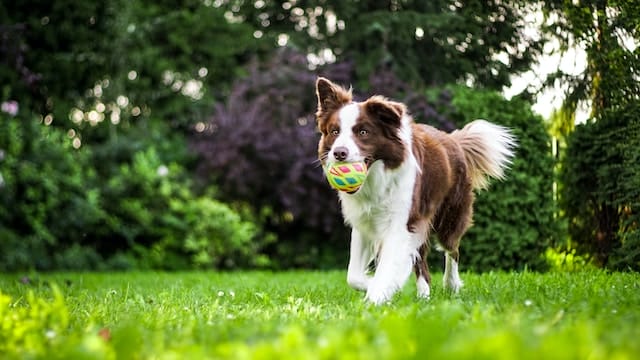With over 66% of US households owning a pet and the vast majority of these pets being dogs, it should be apparent where the phrase “dog is man’s best friend” comes from. However, while plenty of families consider their pet dog a part of the family, not all are au fait with their various traits and actions or what they might mean. While most people understand that a dog wagging its tail usually means it’s happy and relaxed, dogs are able to display a vast range of actions, each with different meanings and characteristics. This post will cover four of the most common and culminate in some advice on ensuring your furriest best friend feels safe and secure in your home.

Splooting Is The Action You Have Seen But Never Considered Before
To start things off, let’s discuss perhaps the most common but oft-overlooked action that you’ve probably never heard of before; splooting. Splooting is when your dog lies on the floor with its hind legs stretched out behind it. There are various reasons why a dog may choose to sploot, ranging from a simple desire to stretch their rear legs and hip muscles to create a larger surface area making cooling more efficient (particularly when on a concrete or tile floor). The intriguing (and informal) name originates in the same way that most new phenomena do, i.e., via a viral social media video of a corgi splooting out on its owners’ floor! Although splooting usually involves both legs, it can sometimes involve only one leg stretching out with the other tucked away, as usual. This behavior is normal and more frequent in certain dog breeds with a higher propensity toward flexibility than in others. Additionally, you are also more likely to observe splooting in older dogs (although there are always exceptions to the rule).
Pacing Could Indicate An Anxious Pooch
If you’ve ever seen videos of animals in poorly operated zoos, you will observe that they are pacing around their units. This has long been considered an indicator of boredom-induced stress, particularly when they have insufficient mental stimulation. If your furry friend seems engaged in constant pacing, one can infer that he might feel anxious, energetic, or simply understimulated. Observing your dog moving around you in swift circular motions is an indication of their playful demeanor, hinting at a desire for you to become part of their energetic escapades. Worth mentioning is a common behavior these creatures exhibit, which is that they have a tendency to chase after their fellow animals, an action independent of their current feeling, be it boredom or enthusiasm.

Baring Teeth Can Mean Your Dog Is Scared Or Angry
If you have ever been in the same room as a dog baring its teeth, you instinctively know that something is not right. If you are a regular, sane individual, it should be pretty scary watching them curl up their lips and bare the entire array of sharp teeth they have at their disposal. In most cases, a dog will bear their teeth when frightened, feel backed into a corner, and feel the need to assert their dominance and willingness to fight if needed. Should you observe your dog displaying signs such as growling or wrinkling its snout, it serves as a warning that your canine companion is in a state of high agitation. For your safety, it’s recommended to maintain a respectful distance from any dog showcasing these behavioral cues. Avoid moving closer in an attempt to comfort it, even if they have been part of your family for a while. Instead, step back and give them room to settle down and no longer feel threatened.
Heavy Panting Might Mean They Are Overheating
Despite the widespread misconception that dogs lack sweat glands, dogs do have a set of glands that can produce sweat. However, although they have glands and do produce a small amount of sweat, it’s insufficient to cool them efficiently. Instead, dogs primarily regulate their body temperature through panting. As they pant, water evaporates from their tongue, nasal passages, and lungs’ lining leading to a cooling effect. Panting can also be an indicator of excitement or stress in dogs and may sometimes hint at health problems. For the most part, panting merely indicates that they are hot and need to cool down. However, if labored or accompanied by other behaviors, it could point to a health issue that requires a visit to your local vet.

How To Ensure Your Dog Feels Safe And Comfortable
If you are reading this post, it is probably because you are interested in learning more about how your dog behaves and are keen on maintaining a healthy and happy animal. If that explanation sounds right, read on to find out a few ways to ensure your pooch is its best self.
Provide A Cozy Bed Space
We all enjoy the comfort of a cozy bed, and a dog is no different in this regard. When you create a comfortable space for your dog to doze off, it will feel snug and secure and less prone to outbursts of anger or aggression.
Establish A Consistent Routine
Dogs are animals of routine and crave a certain level of it in order to stay healthy. You can have different routines that include play, food, and walking, all of which should be performed at the same time each day when feasible.
Offer Mental Stimulation Exercises
If you begin seeing your dog pacing and moping around, it’s possible you aren’t supplying it with enough mental stimulation to keep its brain engaged. Another key sign that it has insufficient stimulation is if it constantly rips up your home and damages shoes and furniture. You should aim to provide it ample opportunities to use its brain for it to feel fulfilled. This might involve various play activities or simply regular walks where it has the chance to sniff around the panoply of different smells and sensations in the neighborhood.
From splooting to snarling, your dog has a wide gamut of emotions and behaviors that demonstrate them. Despite the fact that some are benign, you should be aware of the more hazardous ones so you can take the appropriate action if the need arises.


GIPHY App Key not set. Please check settings